This is section 3, covering sheets 21 through 30 of 65 pages from the archives of the U.S. Navy in a declassified document.
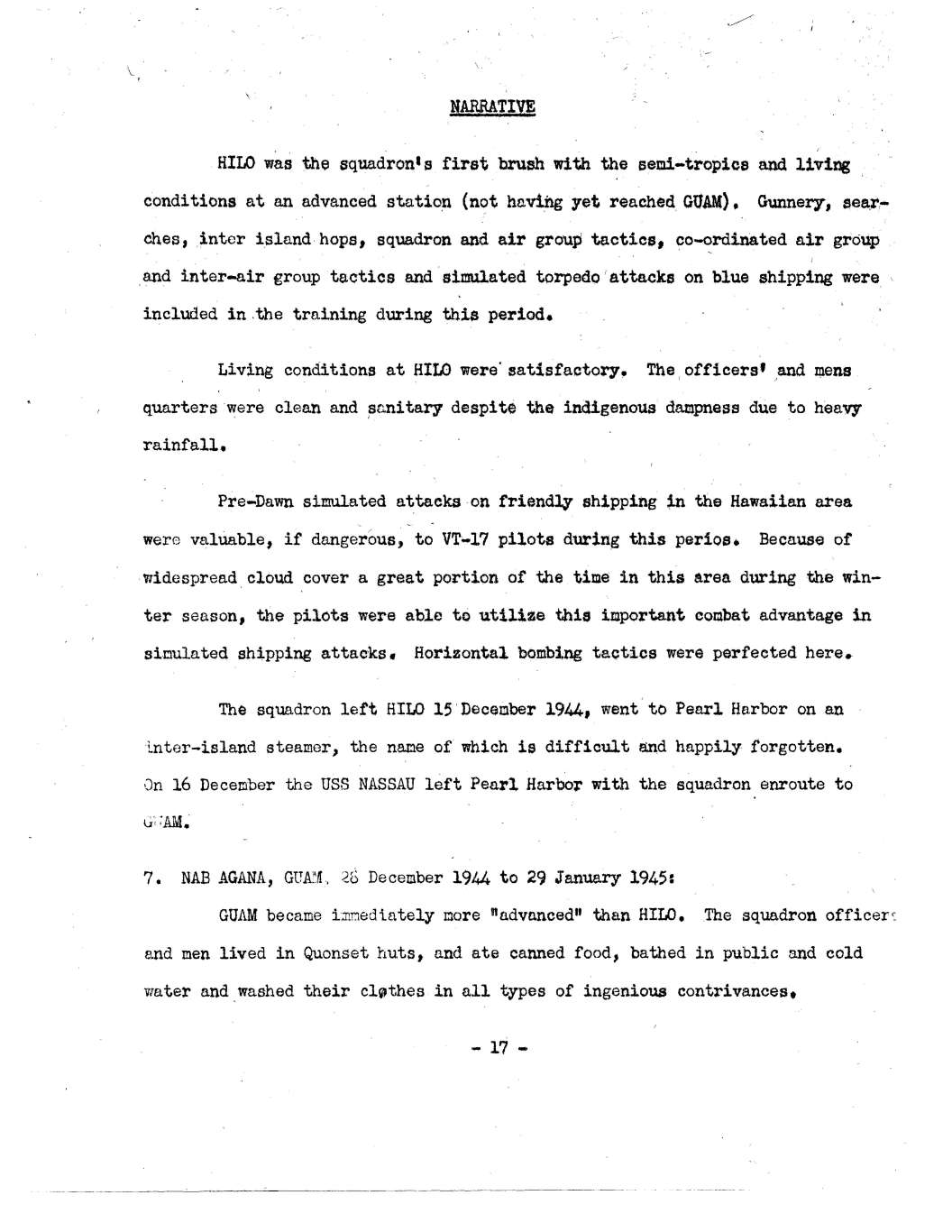
NARRATIVE
HILO was the squadron’s first brush with the semi-tropics and living conditions at an advanced station (not having yet reached GUAM). Gunnery, searches, inter island hops, squadron and air group tactics, co-ordinated air group and inter-air group tactics and simulated torpedo attacks on blue shipping were included in the training during this period.
Living conditions at HILO were satisfactory. The officers’ and mens quarters were clean and sanitary despite the indigenous dampness due to heavy rainfall.
Pre-Dawn simulated attacks on friendly shipping in the Hawaiian area were valuable, if dangerous, to VT-17 pilots during this period. Because of widespread cloud cover a great portion of the time in this area during the winter season, the pilots were able to utilize this important combat advantage in simulated shipping attacks. Horizontal bombing tactics were perfected here.
The squadron left HILO 15 December 1944, went to Pearl Harbor on an inter-island steamer, the name of which is difficult and happily forgotten. On 16 December the USS NASSAU left Pearl Harbor with the squadron enroute to GUAM.
7. NAB AGANA, GUAM 26 December 1944 to 29 January 1945:
GUAM became immediately more “advanced” than HILO. The squadron officers and men lived in Quonset huts, and ate canned foold, bathed in public and cold water and washed their clothese in all types of ingenious contrivances.
– 17 –
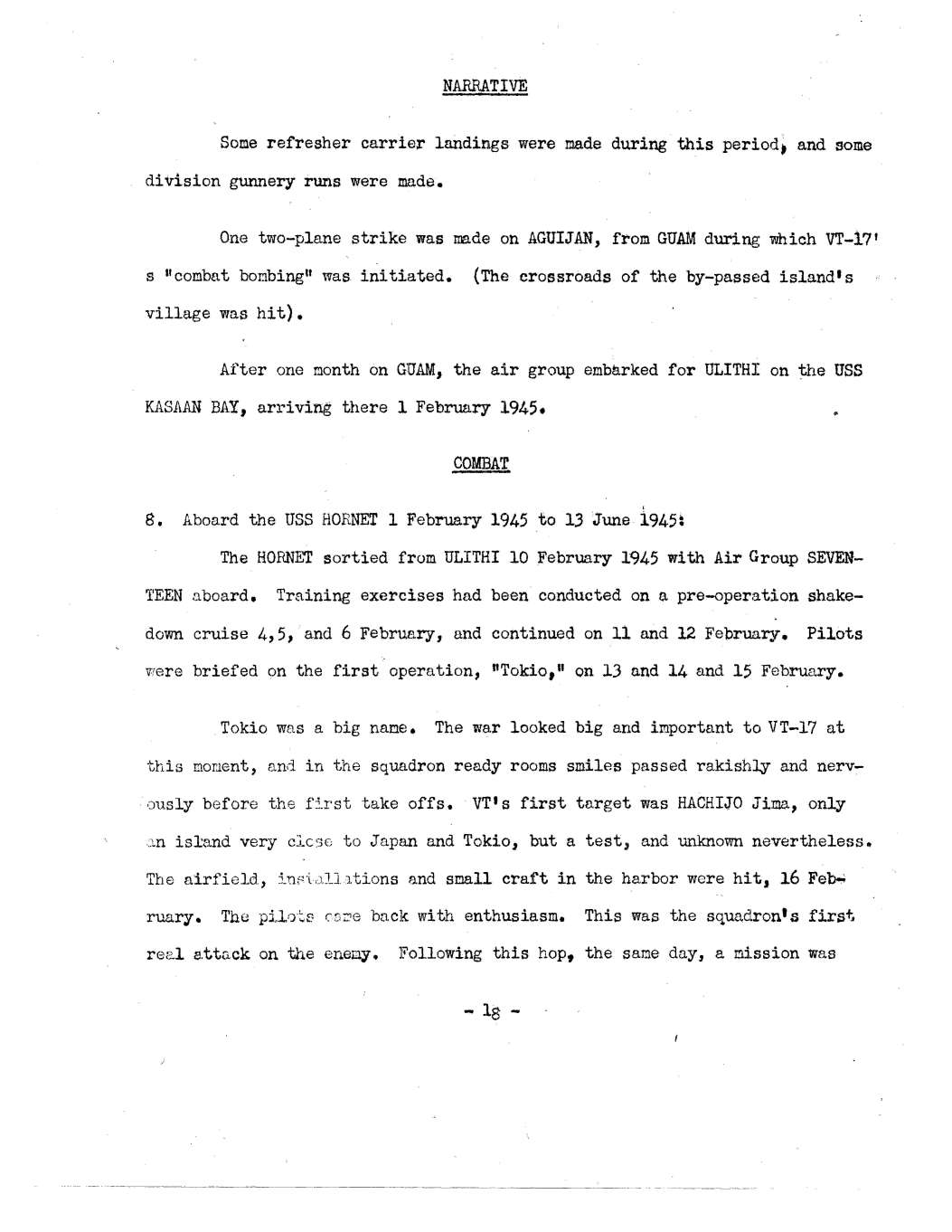
NARRATIVE
Some refresher carrier landings were made during this period, and some division gunnery runs were made.
One two-plane strike was made on AGUIJAN, from GUAM during which VT-17’s “combat bombing” was initiated. (The crossroads of the by-passed island’s village was hit).
After one month on GUAM, the air group embarked for ULITHI on the USS KASAAN BAY, arriving there 1 February 1945.
COMBAT
8. Aboard the USS HORNET 1 February 1945 to 13 June 1945:
The HORNET sortied from ULITHI 10 February 1945 with Air Group SEVENTEEN aboard. Training exercises had been conducted on a pre-operation shakedown cruise 4, 5, and 6 February, and continued on 11 and 12 February. Pilots were briefed on the first operation, “Tokio,” on 13 and 14 and 15 February.
Tokio was a big name. The war looked big and important to VT-17 at this moment, and in the squadron ready rooms smiles passed rakishly and nervously before the first take offs. VT’s first target was HACHIJO Jima, only an island very close to Japan and Tokio, but a test, and unknown nevertheless. The airfield, installations and small craft in the harbor were hit, 16 February. The pilots came back with enthusiasm. This was the squadron’s first real attack on the enemy. Following this hop, the same day, a mission was
– 18 –
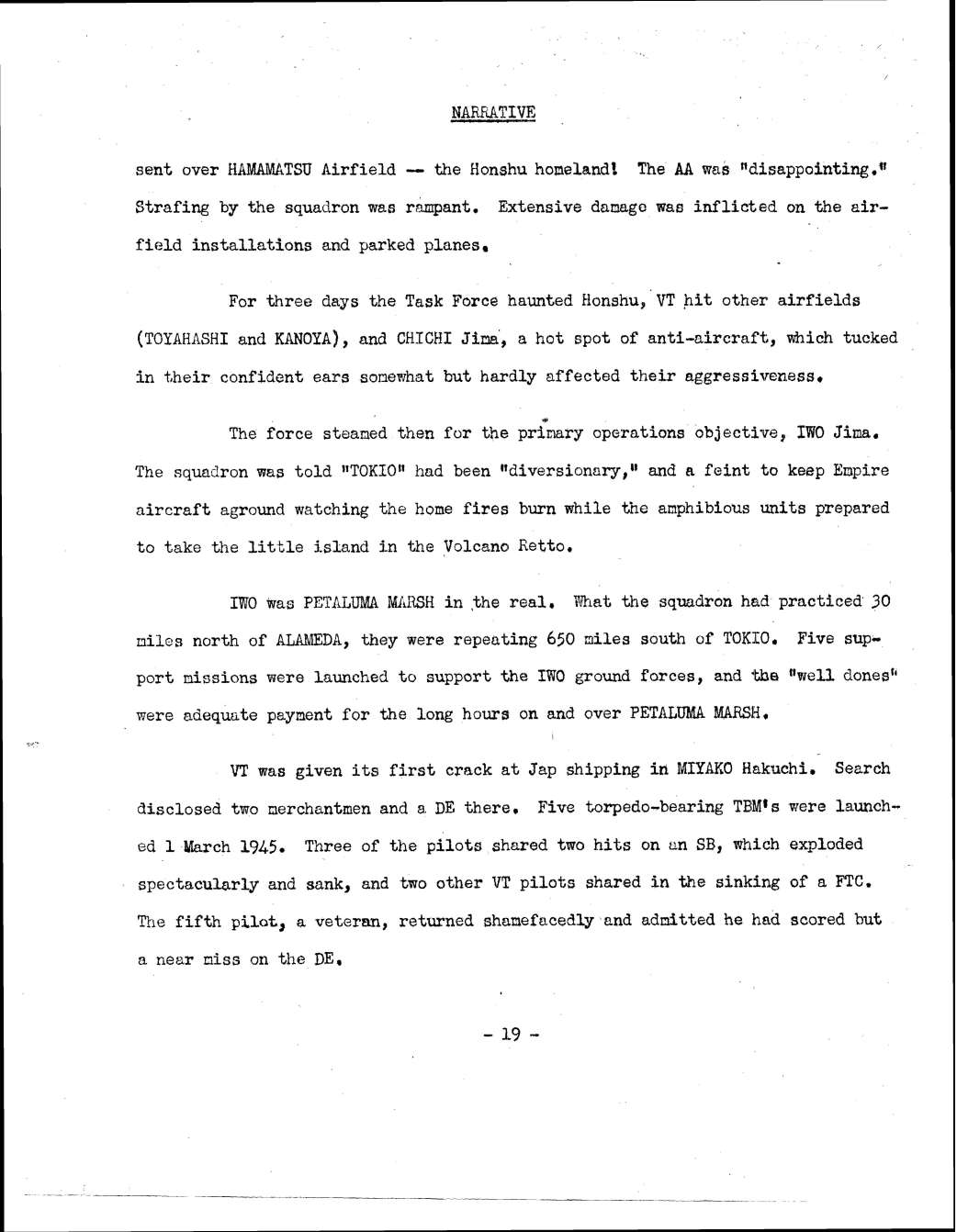
NARRATIVE
sent over HAMAMATSU Airfield – the Honshu homeland! The AA was “disappointing.” Strafing by the squadron was rampant. Extensive damage was inflicted on the airfield installations and parked planes.
For three days the Task Force haunted Honshu, VT hit other airfields (TOYAHASHI and KANOYA), and CHICHI Jima, a hot spot of anti-aircraft, which tucked in their confident ears somewhat but hardly affected their aggressiveness.
The force steamed then for the primary operations objective, IWO Jima. The squadron was told “TOKIO” had been “diversionary,” and a feint to keep Empire aircraft aground watching the home fires burn while the amphibious units prepared to take the little island in the Volcano Retto.
IWO was PETALUMA MARSH in the real. What the squadron had practiced 30 miles north of ALAMEDA, the were repeating 650 miles south of TOKIO. Five support missions were launced to support the IWO ground gorces, and the “well dones” were adequate payment for the long hours on and over PETALUMA MARSH.
VT was given its first crack at Jap shipping in MIYAKO Hakuchi. Search disclosed two merchantmen and a DE there. Five torpedo-bearing TBM’s were launched 1 March 1945. Three of the pilots shared two hits on an SB, which exploded spectacularly and sank, and two other VT pilots shared in the sinking of a FTC. The fifth pilot, a veteran, returned shamefacedly and admitted he had scored but a near miss on the DE.
– 19 –
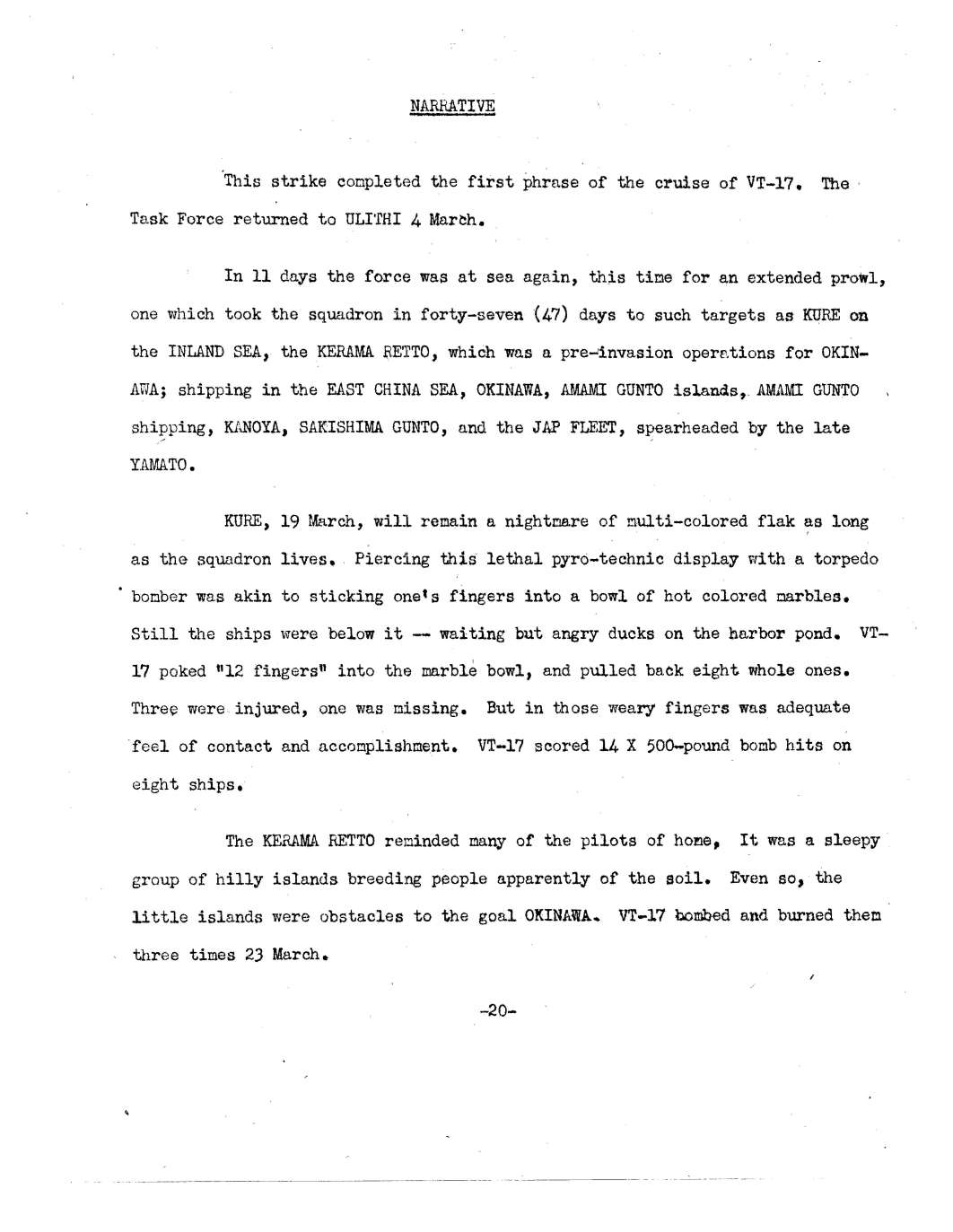
NARRATIVE
This strike completed the first phrase of the cruise of VT-17. The Task Force returned to ULITHI 4 March.
In 11 days the force was at sea again, this time for an extended prowl, one which took the squadron in forty-seven (47) days to such targests as KURE on the INLAND SEA, the KERAMA RETTO, which was a pre-invasion operation for OKINAWA; shipping in the EAST CHINA SEA, OKINAWA, AMAMI GUNTO islands, AMAMI GUNTO shipping, KANOYA, SAKISHIMA GUNTO, and the JAP FLEET, spearheaded by the late YAMATO.
KURE, 19 March, will remain a nightmare of multi-colored flak as long as the squadron lives. Piercing this lethal pyro-technic display with a torpedo bomber was akin to sticking one’s fingers into a bowl of hot colored marbles. Still the ships were below it — waiting but angry ducks on the harbor pond. VT-17 poked “12 fingers” into the marble bowl, and pulled back eight whole ones. Three were injured, one was missing. But in those weary fingers was adequate feel of contact and accomplishment. VT-17 scored 14 x 500-pound bomb hits on eight ships.
The KERAMA RETTO reminded many of the pilots of home. It was a sleepy group of hilly islands breeding people apparently of the soil. Even so, the little islands were obstacles to the goal OKINAWA. VT-17 bombed and burned them three times 23 March.
– 20 –
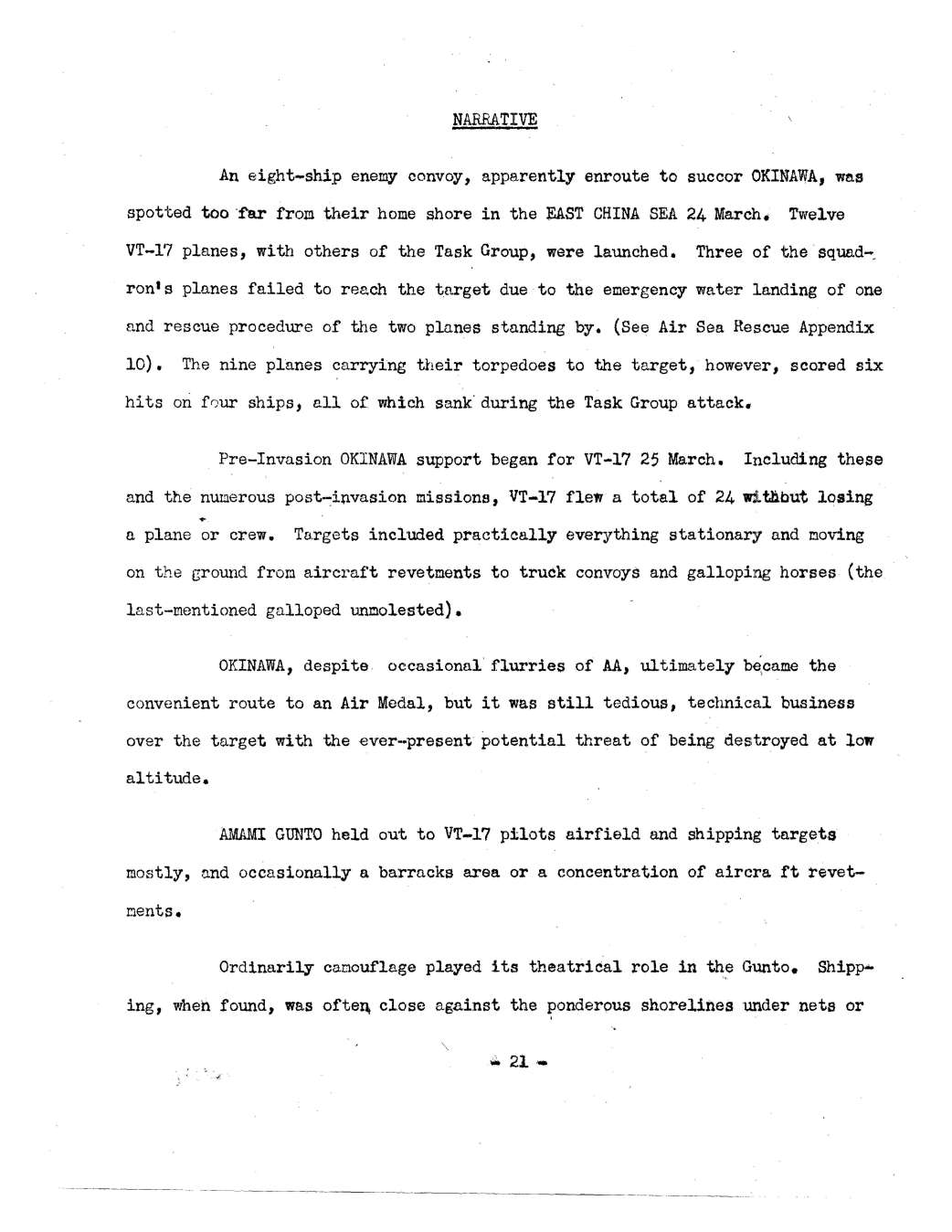
NARRATIVE
An eight-ship enemy convoy, apparently enroute to secure OKIMAWA, was spotted too far from their home shore in the EAST CHINA SEA 24 March. Twelve VT-17 planes, with others of the Task Group, were launched. Three of the squadron’s planes failed to reach the target due to the emergency water landing of one and rescue procedure of the two planes standing by. (See Air Sea Rescue Appendix 10). The nine planes carrying their torpedoes to the target, however, scored six hits on four ships, all of which sank during the Task Group attack.
Pre-Invasion OKINAWA support began for VT-17 25 March. Including these and the numerous post-invasion missions, VT-17 flew a total of 24 without losing a plane or crew. Targets included practically everything stationary and moving on the ground from aircraft revetments to truck convoys and galloping horses (the last-mentioned galloped unmolested).
OKINAWA, despite occasional flurries of AA, ultimately became the convenient route to an Air Medal, but it was still tedious, technical business over the target with the ever-present potential threat of being destroyed at low altitude.
AMAMI GUNTO held out to VT-17 pilots airfield and shipping targets mostly, and occasionally a barracks area or a concentration of aircraft revetments.
Ordinarily camouflage played its theatrical role in the Gunto. Shipping, when found, was often close against the ponderous shorelines under nets or
– 21 –
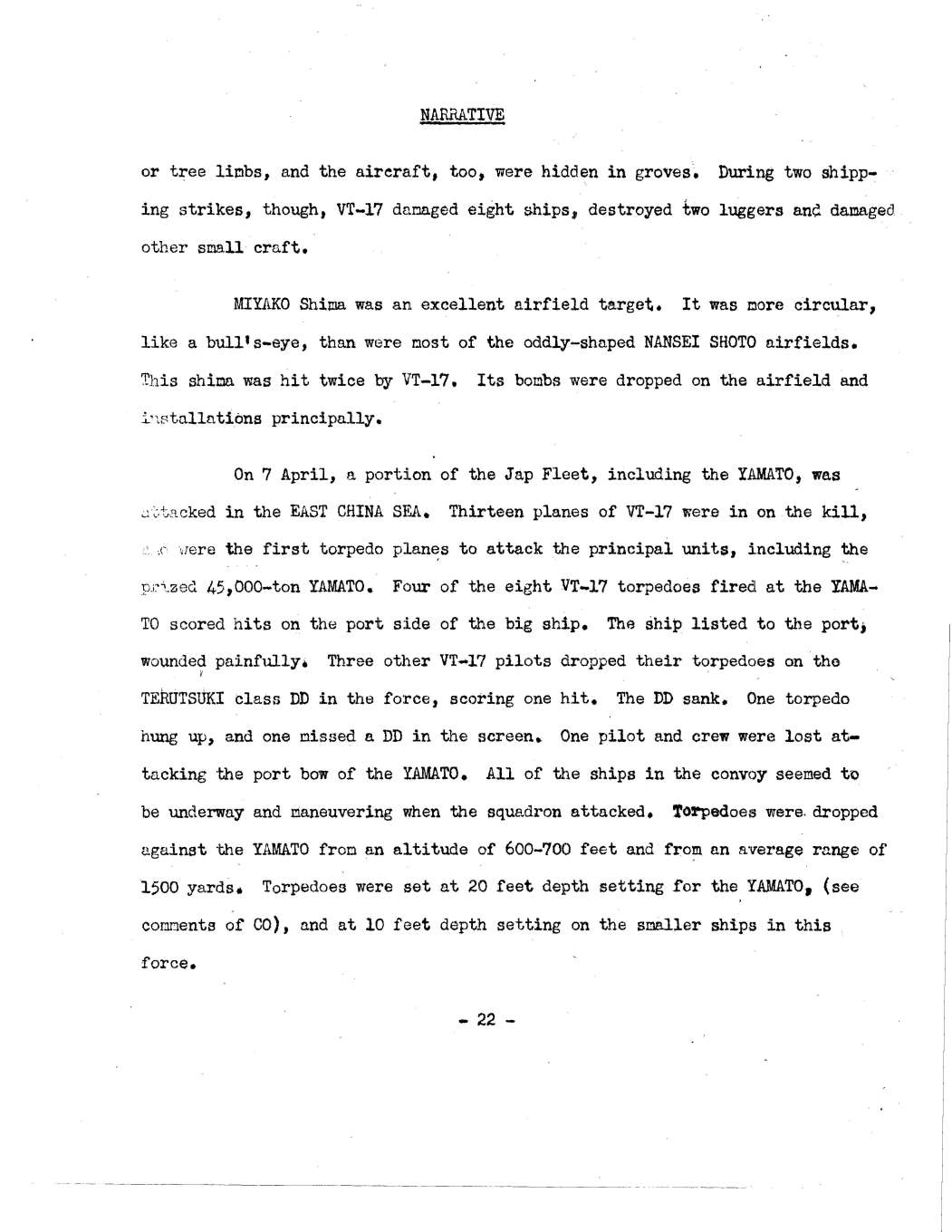
NARRATIVE
or tree limbs, and the aircraft, too, were hidden in groves. During two shipping strikes, though, VT-17 damaged eight ships, destroyed two luggers and damaged other small craft.
MIYAKO SHIMA was an excellent airfield target. It was more circular, like a bull’s-eye, than were most of the oddly-shaped NANSEI SHOTO airfields. This shima was hit twice by VT-17. Its bombs were dropped on the airfield and installations principally.
On 7 April, a portion of the Jap Fleet, including the YAMATO, was struck in the EAST CHINA SEA. Thirteen planes of VT-17 were in on the kill, and were the first torpedo planes to attack the principal units, including the prized 45,000-ton YAMATO. Four of the eight VT-17 torpedoes fired at the YAMATO scored hits on the port side of the big ship. The ship listed to the port, wounded painfully. Three other VT-17 pilots dropped their torpedoes on the TERUTSUKI class DD in the force, scoring one hit. The DD sank. One torpedo hung up, and one missed a DD in the screen. One pilot and crew were lost attacking the port bow of the YAMATO. All of the ships in the convoy seemed to be underway and maneuvering when the squadron attacked. Torpedoes were dropped against the YAMATO from an altitude of 600-700 feet and from an average range of 1600 yards. Torpedoes were set at 20 feet depth setting for the YAMATO, (see comments of CO), and 10 feet depth setting on the smaller ships in this force.
– 22 –
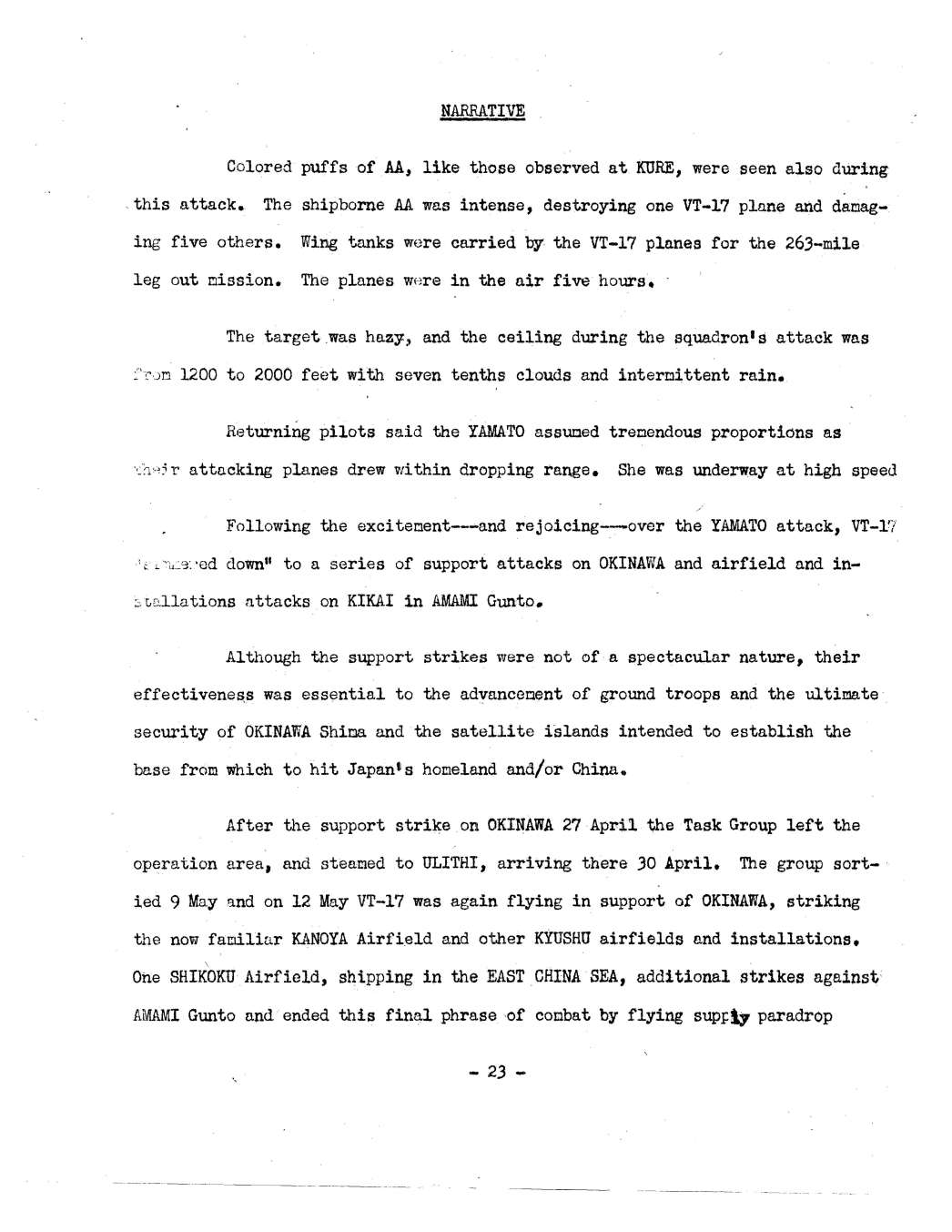
NARRATIVE
Colored puffs of AA, like those observed at KURE, were seen also during this attack. The shipborne AA was intense, destroying one VT-17 plane and damaging five others. Wing tanks were carried by the VT-17 planes for the 263-mile leg out mission. The planes were in the air five hours.
The target was hazy, and the ceiling during the squadron’s attack was from 1200 to 2000 feet with seven tenths clouds and intermittent rain.
Returing pilots said the YAMATO assumed tremendous proportions as their attacking planes drew within dropping range. She was underway at high speed.
Following the excitement — and rejoicing — over the YAMATO attack, VT-17 “simmered down” to a series of support attacks on OKINAWA and airfield and installations attacks on KIKAI and AMAMI GUNTO.
Although the support strikes were not of a spectacular nature, their effectiveness was essential to the advancement of ground troops and the ultimate security of OKINAWA SHIMA and the satellite islands intended to establish the base from which to hit Japan’s homeland and/or China.
After the support strike on OKINAWA 27 April the Task Group left the operation area, and steamed to ULITHI, arriving there 30 April. The group sortied 9 May and on 12 May VT-17 was again flying in support of OKINAWA, striking the now familiar KANOYA Airfield and other KYUSHU airfields and installations. One SHIKOKU Airfield, shipping in the EAST CHINA SEA, additional strikes against AMAMI GUNTO and ended this final phase of combat by flying supply paradrop
– 23 –
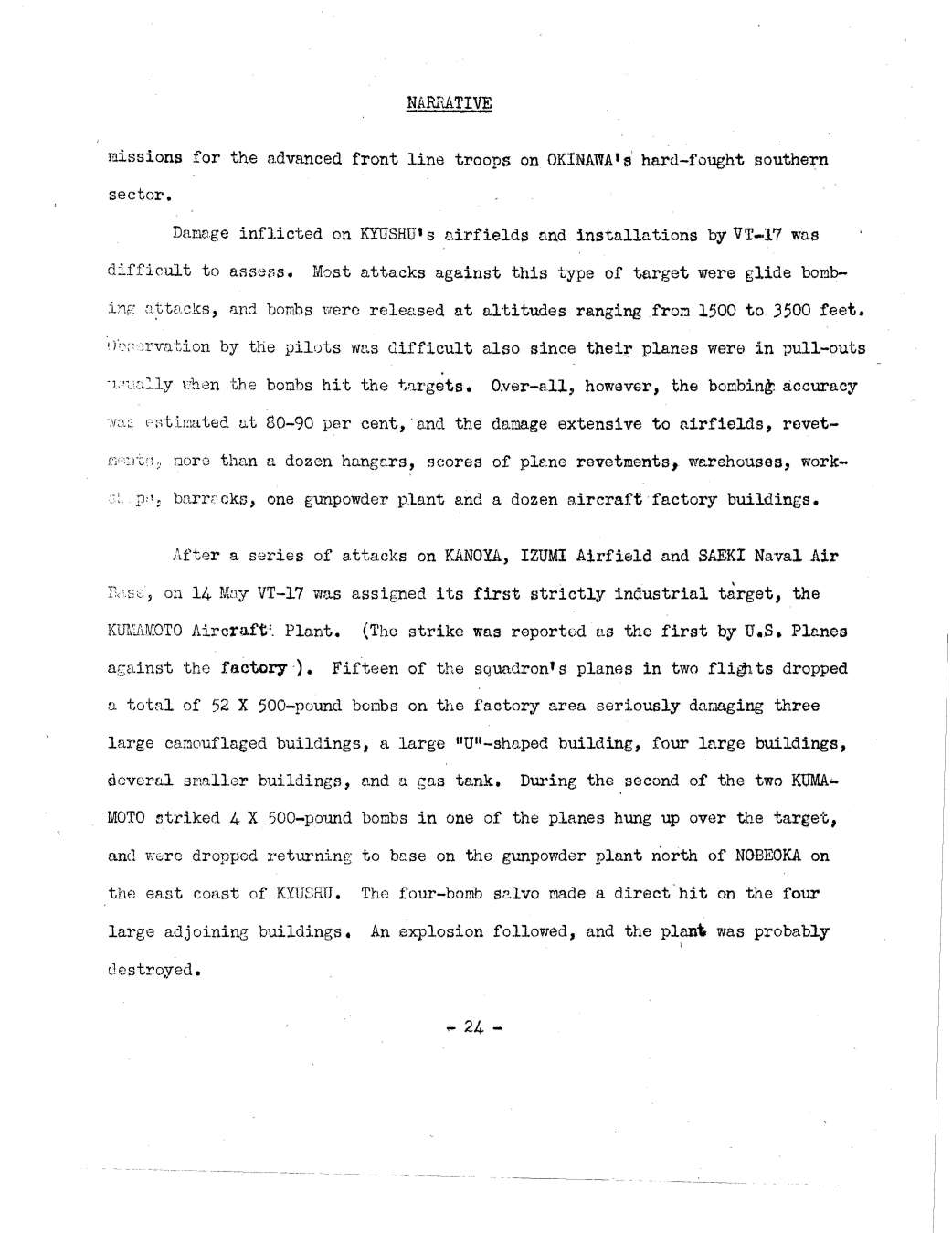
NARRATIVE
missions for the advanced front line troops on OKINAWA’s hard-fought southern sector.
Damage inflicted on KYUSHU’s airfields and installations by VT-17 was difficult to assess. Most attacks against this type of target were glide boming attacks, and bombs were released at altitudes ranging from 1500 to 3500 feet.Observation by the pilots was difficult also since their planes were in pull-outs usually when the bombs hit the targets. Over-all, however, the bombing accuracy was estimated at 80-90 per cent, and the damage extensive to airfields, revetments, more than a dozen hangars, scores of plane revetments, warehouses, workshops, barracks, one gunpowder plant and a dozen aircraft factory buildings.
After a series of attacks on KANOYA, IZUMI Airfield and SAEKI Naval Air Base, on 14 May VT-17 was assigned its first strictly industrial target, the KUMAMOTO Aircraft Plant. (The strike was reported as the first by U.S. Planes against the factory). Fifteen of the squadron’s planes in two flights dropped a total of 52 x 500-pound bombs on the factory area seriously damaging three large camouflaged buildings, a large “U”-shaped building, four large buildings, several smaller buildings, and a gas tank. During the second of the two KUMAMOTO striked 4 x 500-pound bombs in one of the planes hung up over the target, and were dropped returning to base on the gunpowder plant north of NOBEOKA on the east coast of KYUSHU. The four-bomb salvo made a direct hit on the four large adjoining buildings. An explosion followed, and the plant was probably destroyed.
– 24 –
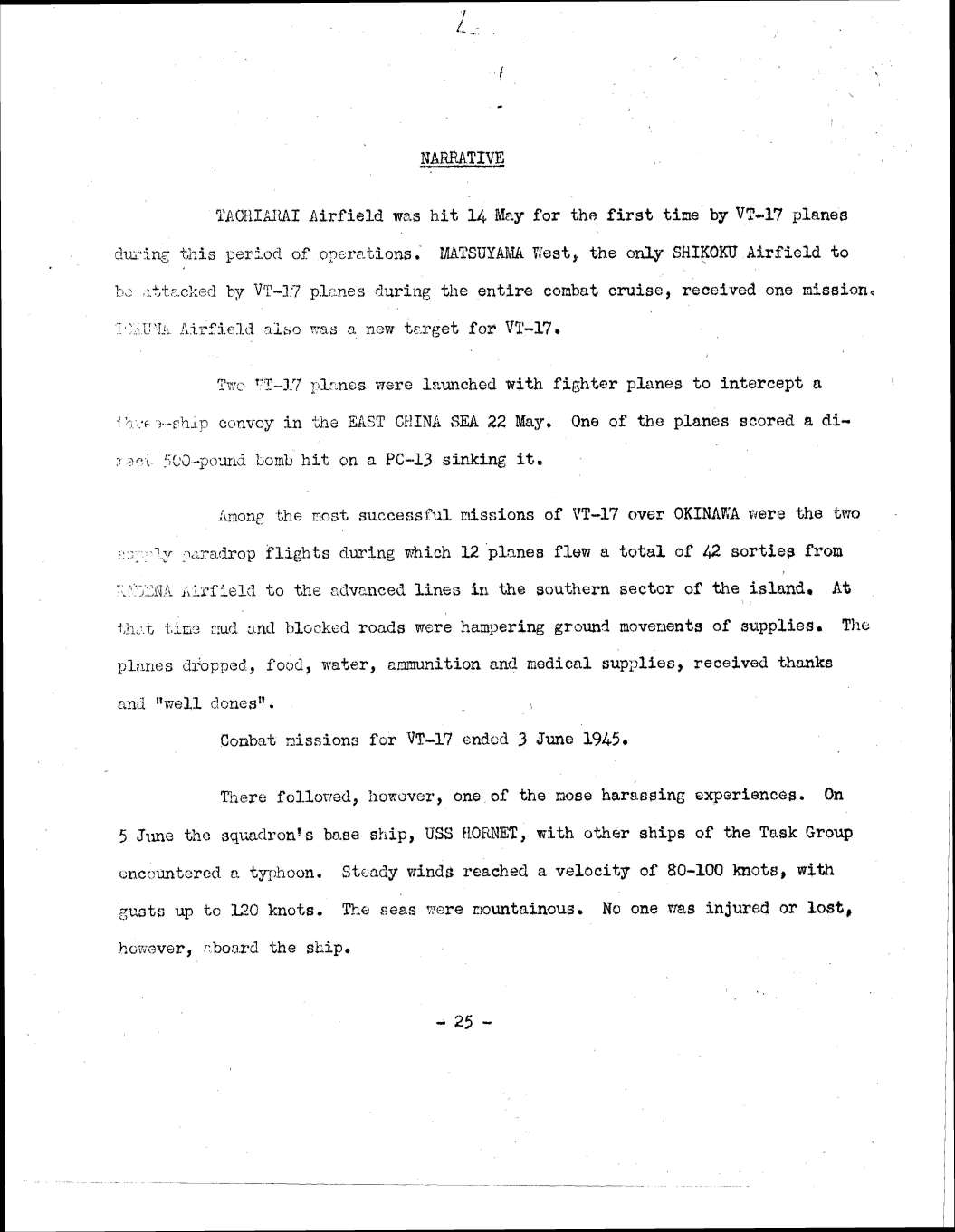
NARRATIVE
TACHIARAI Airfield was hit 14 May for the first time by VT-17 planes during this period of operations. MATSUYAMA WEST, the only SHIKOKU Airfield to be attacked by VT-17 planes during the entire combat cruise, received one mission. TOKUNA Airfield was a new target for VT-17.
Two VT-17 planes were launched with fighter planes to intercept a three-ship convoy in the EAST CHINA SEA 22 May. One of the planes scored a direct 500-pound bomb hit on a PC-13 sinking it.
Among the most successful missions of VT-17 over OKINAWA were the two supply paradrop flights during which 12 planes flew a total of 42 sorties from KADENA Airfield to the advanced lines in the southern sector of the island. At this time mud and blocked roads were hampering ground movement of supplies. The planes dropped food, water, ammunition and medical supplies, received thanks and “well dones”.
Combat missions for VT-17 ended 3 June 1945.
There followed, however, one of the most harassing experiences. On 5 June the squadron’s base ship, USS HORNET, with other ships of the Task Group encountered a typhoon. Steady winds reached a velocity of 80-100 knots, with gusts up to 120 knots. The seas were mountainous. No one was injured or lost, however, aboard the ship.
– 25 –
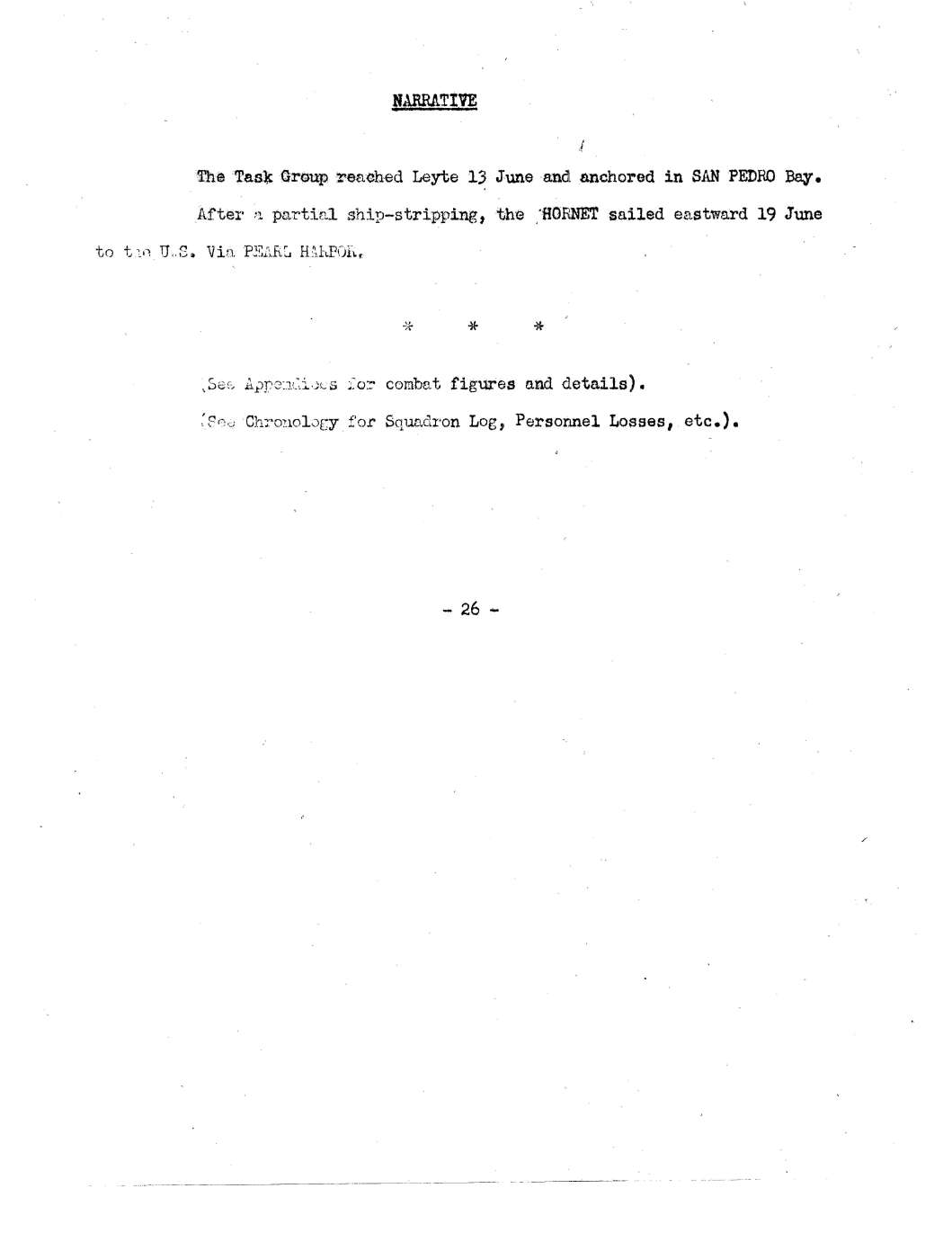
NARRATIVE
The Task Group reached LEYTE 13 June and anchored in SAN PEDRO BAY.
After a partial ship-stripping, the USS HORNET sailed eastward 19 June to the U.S. via PEARL HARBOR.
* * *
(See Appendicies for combat figures and details).
(See Chronology for Squadron Log, Personnel Losses, etc.).
– 26 –
(continued)
VT-17 Historical Report by W. M. Romberger : Click – Part 1 – Part 2 – Part 3 – Part 4 – Part 5 – Part 6 – Part 7


 Donations appreciated.
Donations appreciated.